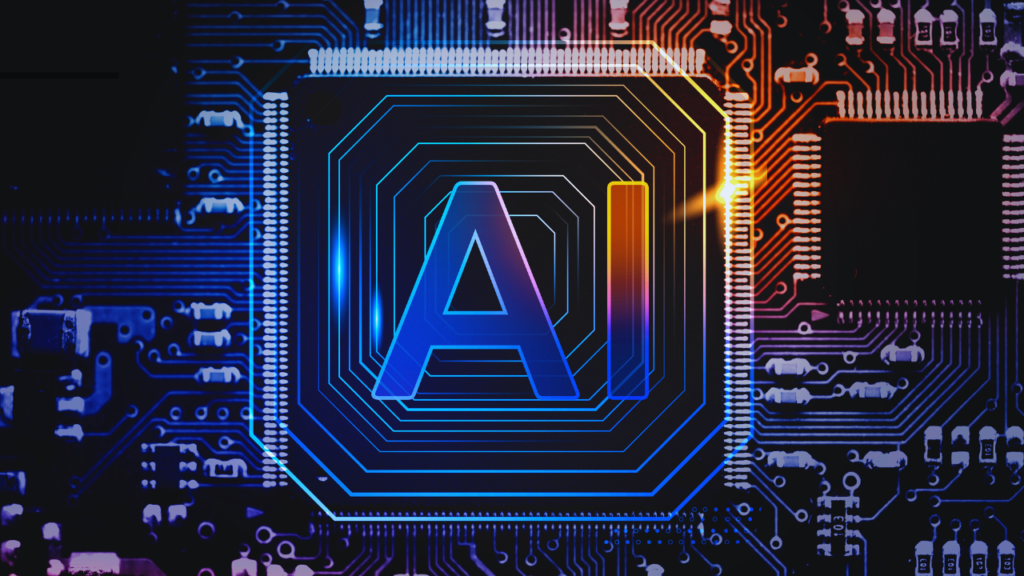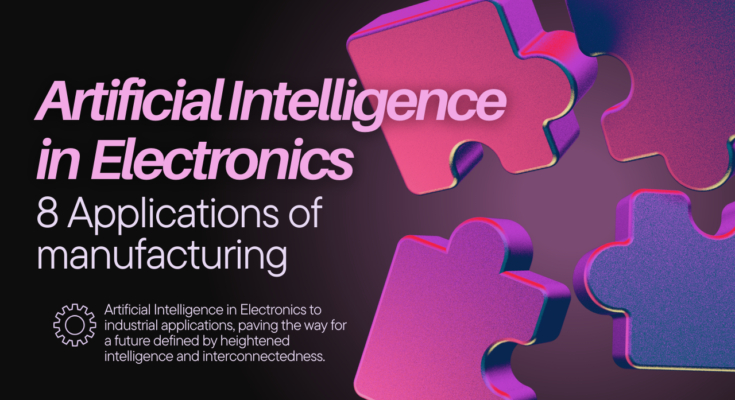Artificial Intelligence in Electronics| 8 Applications of manufacturing
Electronics
Electronics unfolds as a captivating field of study and technology dedicated to the mastery of electric energy. Within its expansive domain, electronics encompasses a diverse array of devices and intricate systems meticulously designed to manipulate and harness the power of electrons for multifaceted purposes. Simply put, electronics serves as the scientific conduit for understanding and managing electric energy, assuming a pivotal role in the profound transformation and shaping of the contemporary world. In the fabric of our everyday existence, technology is seamlessly woven into every facet. Electronic circuits, indispensable to our daily routines, drive a spectrum of devices — from the ubiquitous cell phone linking us to the digital realm to the constant hum of a refrigerator safeguarding our perishable items.
What is meant by Artificial Intelligence?
Artificial Intelligence, often abbreviated as AI, stands as a groundbreaking discipline within computer science. Its primary emphasis is on crafting and advancing intelligent machines that can execute tasks traditionally within the domain of human intelligence. At the heart of AI lies the objective of enabling machines to emulate cognitive functions, including learning, problem-solving, perception, and language understanding. Essentially, AI endeavors to empower machines with the capacity to think, make decisions, and, in certain instances, exceed human capabilities.

Artificial Intelligence in Electronics
Recently, Artificial Intelligence (AI) has emerged as a catalyst, bringing about a fundamental transformation in the realm of electronics. Its presence marks a paradigm shift in our interaction with electronic devices, pushing against conventional norms and propelling technological innovation to unprecedented levels. The far-reaching impact of Artificial Intelligence in Electronics to industrial applications, paving the way for a future defined by heightened intelligence and interconnectedness.

Evolution of Artificial Intelligence in Electronics
Historical Perspective
The inception of Artificial Intelligence in Electronics can be traced back to the nascent days of computing when visionary pioneers conceptualized machines with the potential to replicate human intelligence. This visionary idea marked the embryonic stage of a journey that would redefine the capabilities of electronic devices.
As the years unfolded, a series of remarkable advancements in algorithms and computing power propelled us steadily closer to the realization of this ambitious vision. The evolution of Artificial Intelligence in Electronics is intricately woven into the fabric of technological progress, with each step forward representing a triumph in the quest for machines that can emulate the intricacies of human thought and decision-making.
Key Milestones
The progress of Artificial Intelligence in Electronics follows a developmental trajectory marked by crucial milestones, each contributing significantly to the transformative evolution of this domain. From the initial stages characterized by expert systems to the advent of robust neural networks, this journey underscores a continuous dedication to enhancing the capabilities of intelligent electronic systems.
In its early phases, expert systems laid the foundation for Artificial Intelligence in Electronics, employing rule-based decision-making to automate specific tasks. However, the true watershed moment occurred with the rise of neural networks. Modeled after the human brain, these networks instigated a paradigm shift in how machines process information, empowering them to learn, adapt, and refine their performance over time.
AI/ML Enhances Precision in Electronics Manufacturing Quality Inspections
Artificial Intelligence/Machine Learning (AI/ML) has proven to be a game-changer in the realm of quality inspections within electronics manufacturing. Traditionally, human workers meticulously inspected products as they traversed the manufacturing line. However, with escalating product demands and accelerated timelines, ensuring accurate quality inspections became increasingly challenging.
The inspection criteria broadened to encompass screws, wires, labels, and defects in various vital components. As the shifts progressed, visual fatigue among workers led to a surge in errors. In response to these challenges, in 2022, Flex introduced two AI/ML-based vision detection and inspection systems onto the factory floor.
These systems leveraged trained neural networks to identify defects that proved elusive for conventional vision systems or human inspectors. Post-deployment, the AI/ML system continued to evolve, becoming more intelligent and proficient at capturing errors over time. This implementation marked a significant leap forward in enhancing the accuracy and efficiency of quality inspections in electronics manufacturing.
Opportunities:
While the potential of AI in electronics is undeniably vast, it’s not without its hurdles. As we embrace this powerful technology, maximizing the opportunities becomes crucial. Here’s a breakdown of the key aspects to consider:
| Aspect | Benefits |
|---|---|
| Enhanced Design and Manufacturing | AI can optimize circuit design, predict equipment failures, and streamline production, leading to higher efficiency and improved product quality. |
| Smarter Devices and User Experiences | AI-powered devices can personalize settings, learn from user preferences, and anticipate needs, creating more intuitive and convenient experiences. |
| Predictive Maintenance and Security | AI algorithms can predict device failures and security threats before they occur, minimizing downtime and ensuring data protection. |
| Accelerated Innovation | AI can automate data analysis and discovery, leading to faster development of new electronic products and technologies. |
Applications of Artificial Intelligence in Electronics
Artificial Intelligence in Electronics manufacturing, the pursuit of perfection commences with a thorough examination of every layer and component. This article delves into the pivotal significance of cutting-edge inspection technologies, navigating through different phases of the manufacturing process and the defects they strive to eradicate.
1. Wafer Defect Inspection
Application of Artificial Intelligence in Electronics is Wafer inspection stands as the initial sentinel in semiconductor production. Each layer is carefully examined for imperfections such as cracks, scratches, absent components, and irregularities at the edges. While machine vision streamlines visual inspection, the array of possible defects calls for a more advanced approach. Enter deep learning software, a game-changer in defect identification. Tapped into a varied array of images, this technology discerns defects and anomalies with unmatched precision, guaranteeing the integrity of every semiconductor wafer.
2. Integrated Circuit Inspection
Another Application of Artificial Intelligence in Electronics is Integrated circuits demand microscopic scrutiny for defects bent, missing, or twisted pins that could lead to catastrophic failures. Traditional machine vision systems face challenges with the vast array of defect types. Here, deep learning software shines, classifying defects beyond the capabilities of rule-based systems.
3. PCB Inspection
Application of Artificial Intelligence in Electronics is Printed circuit board (PCB) inspection navigates the intricate assembly steps of small components. Rules-based machine vision falters in defining defects, yet deep learning software empowers manufacturers to detect and categorize these defects accurately.

4. Welding/Solder Inspection
Welding and soldering introduce nuanced variations that machine vision might misinterpret as defects in the field Artificial Intelligence in Electronics . Deep learning software becomes the discerning eye, distinguishing genuine defects from mere image variations.
5. Consumer Electronics Final Inspection
Completed electronic products demand a stringent quality check. Machine vision excels in automated control, but deep learning software surpasses in identifying elusive flaws—dents, scratches, and abnormalities that might escape traditional inspection methods.
6. Display Inspection
Electronic displays face scrutiny for imperfections like dust, scratches, and cracks. Rules-based machine vision falters, but deep learning software, honed on defective and non-defective images, ensures accurate pass/fail determinations.
6. Surface Inspection
Ensuring flawless surfaces on electronic products poses challenges. Deep learning software, trained on images of defects and perfection, delivers reliable pass/fail results where traditional machine vision techniques fall short.
7. Battery Inspection
Application of Artificial Intelligence in Electronics is Battery production, with its diverse steps, presents various defects—surface flaws, dents, scratches, bends, and corrosion. Deep learning software adapts seamlessly, accommodating the myriad defects that may arise during battery manufacturing.
8. Solar Panel Inspection
Solar panel inspection scrutinizes layers of photovoltaic cells. Defects such as cracks, scratches, and bubbles threaten efficiency. Visible and non-visible imaging techniques are employed, with deep learning software distinguishing acceptable variations and myriad defects.


